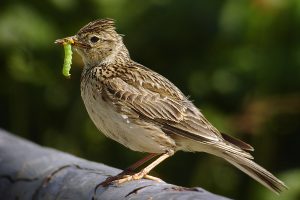Natural areas represent half of the territory of the European Union and are essential for the conservation of biodiversity, on which our survival depends. Yet, in recent decades, intensive agriculture and the progressive abandonment of rural areas have led to a rapid, continuous decline of many wild animal and plant species that inhabit the uncultivated lands and areas nowadays dedicated to agriculture and grazing.
The Farmland Bird Index (FBI) shows that in the European Union bird populations have decreased by nearly 30% since 1990. Currently, around 39% of cropland bird populations are decreasing. Similarly, between 1990 and 2011, the grassland butterfly population fell by 50%, indicating a considerable loss of grassland biodiversity (EU, 2019. Biodiversity in farming)
Intensive agriculture and abandonment of rural areas: a dangerous threat to local biodiversity
Intensive agriculture is seriously endangering local biodiversity. The main causes include the massive use of fertilizers and pesticides, the mowing of lawns in extremely short times and on very large scale, and the endless areas that have replaced the traditional “mosaic” landscape (with small fields alternating with natural environments).
Birds, a group of species considered an excellent indicator of agricultural biodiversity, are in sharp decline as these changes, exacerbated by the climate crisis, have taken away their nesting sites, insects, seeds and refuge areas. The populations of some species have thus drastically reduced, until they disappeared from ever larger areas.

Among the most endangered species we can mention the red-backed shrike (Lanius collurio), the house sparrow (Passer domesticus – it has lost 50% of its population since 1980, a total of 247 million birds in the UK and EU) and the skylark. Over the past 40 years, skylarks (Alauda arvensis) in Europe have suffered a 50% decline due to the intensification of agriculture. A research by the London-based Royal Society for the Protection of Birds (RSPB) shows that the use of fungicides has been one of the major causes for the skylark decline. It has allowed the autumn sowing of cereals, which has led to lack of crop stubble during the autumn season. Farmland birds feed on this stubble left in fields between the summer harvest and spring planting. But the trend towards autumn planting has cut off this food source, thereby leading to the starvation of a large number of birds.
The land-use intensification has negative consequences on soil biodiversity as well: it reduces the complexity in the soil food webs, as well as the community-weighted mean body mass of soil fauna. In all regions across Europe, species richness of earthworms, Collembolans, and oribatid mites are negatively affected by increased land-use intensity.
The abandonment of rural areas as well has important consequences on biodiversity conservation. Traditional crops, now mostly confined to hills and mountain areas, are unable to cope with the competition from intensive cultivation and they are gradually abandoned. As a result, a certain landscape and the species that inhabit it are disappearing. Measures on a local scale are not enough to counter the decline of biodiversity: instead, it is necessary to identify criteria for maintaining agricultural activities that favor natural processes and help to preserve the balance of ecosystems.
High Nature Value Farmlands
Some agricultural practices can be valuable allies for the conservation of semi-natural habitats related to agriculture. It was in the early 90s that we began to talk about High Nature Value Farmlands (HNVF). They are areas in which agriculture is the main form of land use and hosts a high diversity of species and habitats. They can be areas characterized by extensive agriculture, mosaic agriculture or agricultural areas that support rare species. What unites them is sustainable agriculture from an environmental point of view.
HNVFs represent 30% of European agricultural areas. They are present in all countries, but mainly located in mountain areas, in North-western Europe areas with extremely humid climates and in the arid areas of the Mediterranean.
HNVFs in Italy
According to the National Institute of Agricultural Economics (INEA), a quarter of the Italian agricultural area (three million hectares) can be considered as “High Natural Value” areas. The difference is made by many factors: among the main ones, the absence of irrigation, poor plowing, crop rotation, natural fertilization, the presence of olive groves, rice fields or non-cultivated elements such as hedges and groves. But the maintenance of such agricultural systems is heavily dependent on the support of the future Common Agricultural Policy (CAP – a common policy for all the EU countries, that pays subsidies to farmers).
It’s thus clear that enhance biodiversity in our agricultural system is a key challenge to sustain the survival of many endangered species. Some solutions already exist and they should be supported by the European Union. What can make a real difference is showing farmers that biodiversity is an ally and that a well-structured food web in the fields can fight crop pests and diseases, while a good soil diversity can increase fertility without an input from chemical fertilizers. An open dialogue with farmers, agronomists and biodiversity experts would result in the application of new agricultural schemes, with benefits both for farmers and for many endangered species linked to well preserved agro-ecosystems, without depending solely on subsidies from the European Union.


No responses yet